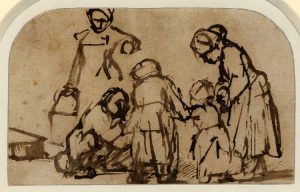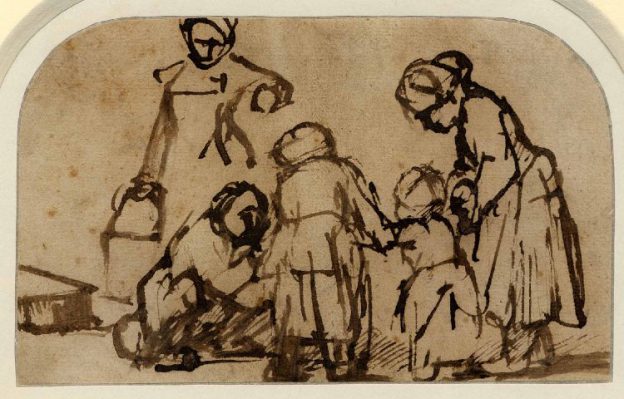One of the research data spring projects, Artivity, is looking at new ways in which we can help artists not only improve their practice by automatically recording the steps they take in creating the chef d’oeuvre, but also collect and share the artistic ‘research data’. In this blog post, Gino Ballantyne, an established artist and a tester of Artivity, talks about his experience with the tool and how it is helping him track his creative journey. The Artivity team will be demo-ing the tool at the final research data spring showcase. If you would like to meet them and find out more about the other projects, then register for the showcase here.
Reflection for my Practice, “Humanising Data”
Artivity captures computer data as a reference tool for an artist when making work on a computer. The way I understand it, Artivity records my journey through the making process by self-archiving the steps I take, building a narrative about my practice. The context of my work can be recognized, and the creative work I make can be explored. Photoshop, Illustrator and Chrome are currently the applications I am using for Artivity to capture data.
Collecting data in a creative practice using a self-archiving process is very helpful. Data is an autonomous language as image and text are, and another media for artists to use. In this instance the work I am contributing for Artivity is about, “Humanising Data”, this is my context. I act as a vector virus to erupt data’s natural order, reflecting human activity in a data driven world.
In 1992 I first used Photoshop to paint and Illustrator to draw. Illustrator used mathematical equations to allow straight, flowing lines, curves and shapes to be drawn. Numbers transformed into images using a vector process.
Using these applications to draw reignited earlier childhood thoughts. It was 1969 and the Apollo 11 mission to land on the Moon happened. It was an adventure and I was allowed to stay up and watch it on a black and white TV, and it was to be screened live into my living room. Filling my childhood imaginary worlds with numbers, images, text, and sounds. That was when I first heard as something important the words, computer, data and digital and first heard “Space Oddity” by David Bowie.
Gottfried Wilhelm Leibniz invented the binary number system in 1697 and when linked to electronic circuits it enabled the computation of all numbers using 0 and I. Eventually transforming words objects and images into data. The later popularity of Social media raised the profile of data as an autonomous language. I believe this socialization process is important to the development of any language because it enables a process of connectivity. This connectivity forms a collective energy to widen experience and develop the human condition.
I have visited many institutions as both artist and lecturer and used tracking tools to engage learners but when students don’t engage actively with these processes gaps form. I think Artivity will help with the assessment of the critical thinking process of the student. When learners proactively engage with learning it is always better, and finding human ways to communicate with students totally immersed in our data driven world is always an asset. Artivity adds a very important component and that is an unobtrusive real time recording of the student’s process.
In my experience as an educator evaluating student’s progress could be unequal. Some students would present just the finished work, which had to be assessed against criteria, which expected a thoroughly academic approach presenting process, research and development. Usually this meant that those student’s who were very talented artistically but with little interest in the academic skills, when judged against the student who was essentially better academically with a modicum of artistic talent, fared worse. Artivity offers the less academically gifted student potential to self-archive their process and present this as part of their academic trail in a real time document. Artivity makes no assumptions about the student process but it could help articulate the completeness of it for assessment purposes, giving meaning to open education practices.
Data has the potential to dominate consciousness, a technological process of industrialization, slowly seeping away an active supportive and variable human condition. In a world of data, recording and encapsulating all the neurotic thoughts of the individual, with its constant replay function further deepening the neurosis. Students need a human guide. Artivity helps to bridge the rational to the human. There is a lovely drawing by Rembrandt of adults teaching a child to walk completely supported in that risky leap of faith by the surrounding adults. Artivity acts like a helping hand, a supportive human guide.

A child being taught to walk; two girls, seen from behind, supporting the child on either side, a figure seated on the ground at left encouraging the child, a woman standing behind with a pail. c.1656
British Museum CC BY-NC-SA 4.0
Pen and brown ink on brownish-cream paper.
To live in Rembrandt’s time posed different questions but the need to walk out in the world and make your own way was a natural progression within a community. Today it is more likely that a child’s progression has a narrower narcissistic context. The world they grow up in is remoter, less socialization through the generations occurs, individual satellites attracting like for like, less of a community more of a collective. The data language they understand available at the push of a button, Social media a constant feedback loop where mistakes are polarized. Conversations made through portals rather than face to face. The immediacy of these transactions gives their life meaning and actuality. Isolation from the world around becomes a major factor when these transactions are not taking place. Artivity it seems to me could act as the “human agent” strengthening understanding between educator and student.
I grew up surrounded by an autonomous world of words and images linked to objects, which engaged with forms of abstraction, increasingly seeking new enigmas to rhapsodize about. This existential moment felt like man’s need to rationalise was gradually aligning with an increasingly data driven world. Meaning, implied through reason the binary, yes or no.
I make work about connectivity investigating the technologies, which socialize our world. Artivity doesn’t help me do this but by considering its process I further understand its nature. When making a 30 second analogue drawing in real time, which intelligently evolves informed by years of sustained knowledge and learning, I adapt my process using a language of marks to connect to the object. I can still do this using a computer but I have to recognize its inherent differences. Artivity’s data process is linear the opposite of mine which seeks to connect to and from, Heraclitus would describe this as the “Unity of the Opposites”.
During this Artivity investigation refining systems and strategies I used led me to adopt a vector virus approach. In this instance I am the human vector anarchically inserting my non-linear approach into the rational linear data medium. The intention is to challenge it, to produce risky intelligent results, resulting in eruptions of possibilities.
Throughout history analytical philosophers, mathematicians and logicians have looked to transform the world and our understanding of it into data. The technologies developed over the last 65 years have made this a reality and Artivity is a part of that. Artivity uses a process of documentation to help define the methods I employ and the approaches I deploy. It isn’t there to supply answers and that’s its strength. It produces data that history and I can analyse. It allows me to unobtrusively invest time in tracking my process and recognize potential during earlier stages of this process. Because the documentation it captures is recorded factually without distortion it offsets any language of myth that might be applied retrospectively, it offers a sense of balance
Developing Connectivity after Artivity by Translating Surface
Documentation plays a major role in contemporary art to disassociate from the past – the narrative baggage of history, and its aesthetic – to create its own narrative (history), for its preferred use of media. This disconnect from history in turn releases contemporary art from comparative associations, discussions about aesthetics and the quality of outcomes. Interestingly contemporary arts medium of choice photographic and new media appear to be on the cusp of something new and more exciting. The translation of surface, one of those discussions it resists due to the natural limitations of those mediums will have to be revisited.
Previously I struggled with the finished surface qualities that result when digital files are in the print stage. Wonderful special effects and tailored actions helping to develop images on screen become like “Emperor’s New Clothes” flattened surface possibilities. Images articulated by inarticulate output, unable to take advantage of the complexities of human perception.
Print technologies have matured offering more opportunities for surface translation. This is where my work made for Artivity is leading me. Data transposed into surface eruptions, the vector viruses will erupt from their data forms into real surface data forms. I look forward to potential ways to develop my work using new and engaging printing processes, digital and analogue, or combined, to translate my work on screen into tangible human objects.
The way forward is to research ways to use my vector viruses in 3D or laser etched printing or perhaps 4D printing, where time is used as the fourth dimension.
Without the Artivity research project I might not have connected, at this moment, with this.
![]() About the author: Gino Ballantyne is an artist. He was born in Malta and studied at The Glasgow School of Art (1983 – 1987), the University of the Arts London, Wimbledon College of Art (2007 – 2009) and Oxford Brookes University. He has exhibited widely and his work is held in private and public collections both nationally and internationally.
About the author: Gino Ballantyne is an artist. He was born in Malta and studied at The Glasgow School of Art (1983 – 1987), the University of the Arts London, Wimbledon College of Art (2007 – 2009) and Oxford Brookes University. He has exhibited widely and his work is held in private and public collections both nationally and internationally.

